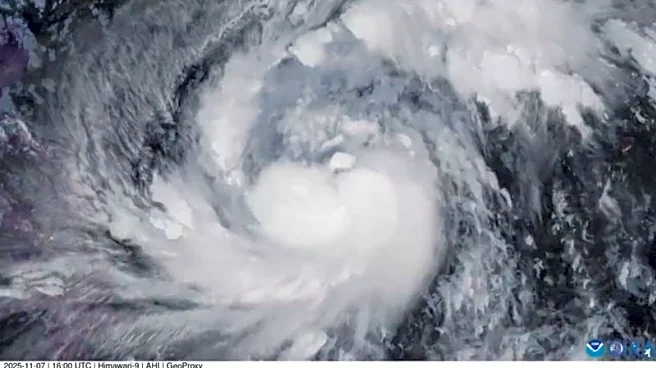What's Happening?
Typhoon Fung-wong has been upgraded to super typhoon status as it approaches the Philippines, bringing sustained winds of 185 km/h and torrential rain. The storm is expected to impact several areas, with
particular concern for the island of Catanduanes, which was the first to be directly hit. Residents in low-lying and coastal areas have been urged to evacuate to higher ground. The typhoon follows closely after Typhoon Kalmaegi, which caused significant destruction and resulted in nearly 200 deaths. Schools have canceled classes or moved them online, and Philippine Airlines has canceled several local flights in anticipation of the storm's arrival.
Why It's Important?
The arrival of Typhoon Fung-wong poses a significant threat to the Philippines, a country highly vulnerable to tropical cyclones due to its location. The storm's impact could exacerbate the already dire situation following Typhoon Kalmaegi, which left a trail of destruction and numerous casualties. The potential for further damage and loss of life underscores the importance of effective disaster preparedness and response. The economic impact could be substantial, affecting local businesses, infrastructure, and the livelihoods of residents in affected areas.
What's Next?
As Typhoon Fung-wong makes landfall, it is expected to weaken but will likely remain a typhoon as it travels over Luzon. Authorities will continue to monitor the storm's progression and provide updates to ensure public safety. The focus will be on rescue operations and providing aid to affected communities. The government and disaster response teams will need to coordinate efforts to mitigate the impact and support recovery efforts in the aftermath of the storm.
Beyond the Headlines
The frequent occurrence of powerful typhoons in the Philippines highlights the broader issue of climate resilience and the need for sustainable development practices. The country's vulnerability to such natural disasters calls for increased investment in infrastructure that can withstand severe weather conditions and improved emergency response systems. Additionally, the social and economic disparities that exacerbate the impact on poorer communities need to be addressed to reduce the long-term consequences of such events.












